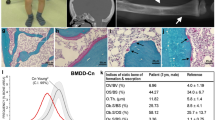Abstract
Camurati-Engelmann disease (CED, MIM 131300) is an autosomal dominant, progressive diaphyseal dysplasia characterized by hyperosteosis and sclerosis of the diaphyses of long bones1. We recently assigned the CED locus to an interval between D19S422 and D19S606 at chromosome 19q13.1–q13.3 (ref. 2), which two other groups confirmed3,4. As the human transforming growth factor-β1 gene (TGFB1) is located within this interval5, we considered it a candidate gene for CED.
This is a preview of subscription content, access via your institution
Access options
Subscribe to this journal
Receive 12 print issues and online access
$209.00 per year
only $17.42 per issue
Buy this article
- Purchase on Springer Link
- Instant access to full article PDF
Prices may be subject to local taxes which are calculated during checkout

Similar content being viewed by others
References
Makita, Y. et al. Am. J. Med. Genet. 91, 153– 156 (2000).
Ghadami, M. et al. Am. J. Hum. Genet. 66, 143– 147 (2000).
Janssens, K. et al. J. Med. Genet. 37, 245– 249 (2000).
Vaughn, S.P. et al. Genomics 66, 119–121 (2000).
Fujii, D., Brissenden, J.E., Derynck, R. & Francke, U. Somat. Cell Mol. Genet. 12, 281–288 (1986).
Syrris, P. et al. Clin. Sci. 95, 659–667 (1998).
Munger, J.S. et al. Kidney Int. 51, 1376– 1382 (1997).
Burt, D.W. & Paton, J.R. DNA Cell Biol. 11, 497–510 (1992).
Ballock, R.T. & Roberts, A.B. Growth Factors: A Practical Approach 85–107 (IRL Press at Oxford University Press, Oxford, 1993).
Erlebacher, A. & Derynck, R. J. Cell Biol. 132, 195–210 ( 1996).
Erlebacher, A., Filvaroff, E.H., Ye, J.-Q. & Derynck, R. Mol. Biol. Cell 9, 1903–1918 (1998).
Filvaroff, E. et al. Development 126, 4267– 4279 (1999).
Acknowledgements
We thank our patients for their participation. This study was supported by Grants-in-Aid (11470507 for N.N.; 11672252 for K.Y.; 10770489 for H.T.) from Ministry of Education, Science, Sports and Culture, and from Ministry of Health and Welfare of Japan.
Author information
Authors and Affiliations
Corresponding authors
Rights and permissions
About this article
Cite this article
Kinoshita, A., Saito, T., Tomita, Ha. et al. Domain-specific mutations in TGFB1 result in Camurati-Engelmann disease. Nat Genet 26, 19–20 (2000). https://doi.org/10.1038/79128
Issue Date:
DOI: https://doi.org/10.1038/79128
This article is cited by
-
The roles and regulatory mechanisms of TGF-β and BMP signaling in bone and cartilage development, homeostasis and disease
Cell Research (2024)
-
A primer on skeletal dysplasias
Japanese Journal of Radiology (2022)
-
The combined prevalence of classified rare rheumatic diseases is almost double that of ankylosing spondylitis
Orphanet Journal of Rare Diseases (2021)
-
Deficiency of TMEM53 causes a previously unknown sclerosing bone disorder by dysregulation of BMP-SMAD signaling
Nature Communications (2021)
-
Significant Improvement After Surgery for a Symptomatic Osteoblastoma in a Patient with Camurati–Engelmann Disease: Case Report and Literature Review
Calcified Tissue International (2021)



